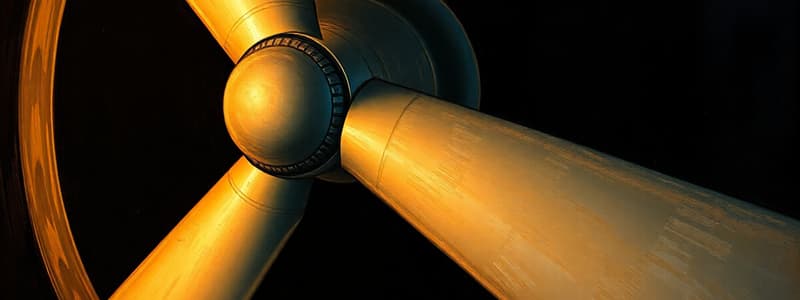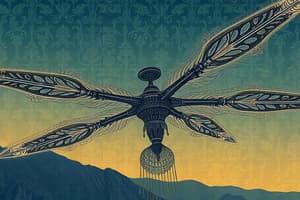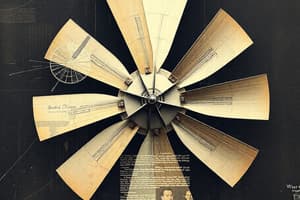Podcast
Questions and Answers
Which inspection method is primarily used for composite rotor blades?
Which inspection method is primarily used for composite rotor blades?
- Ultrasonic testing
- Tap testing (correct)
- Dye penetrant testing
- Visual inspection
Where are additional double plates typically found on a rotor blade?
Where are additional double plates typically found on a rotor blade?
- At the leading edge
- At the trailing edge
- At the root of the tip (correct)
- At the center of span
What is the primary purpose of spanwise balance weights on a rotor blade?
What is the primary purpose of spanwise balance weights on a rotor blade?
- To increase blade strength
- To achieve balance along the blade's length (correct)
- To control blade tracking
- To adjust blade pitch
If a helicopter has a weight added to the leading edge of a blade, how would it affect the plane of rotation?
If a helicopter has a weight added to the leading edge of a blade, how would it affect the plane of rotation?
Where are trim tabs typically located on a rotor blade?
Where are trim tabs typically located on a rotor blade?
Which control is typically rigged first on a helicopter?
Which control is typically rigged first on a helicopter?
Where is the servo flap located on a rotor blade?
Where is the servo flap located on a rotor blade?
What is a benefit of using main servo flaps?
What is a benefit of using main servo flaps?
What is a key characteristic of an asymmetrical rotor blade?
What is a key characteristic of an asymmetrical rotor blade?
Why are symmetrical rotor blades more commonly used than asymmetrical ones?
Why are symmetrical rotor blades more commonly used than asymmetrical ones?
What is a uniform planform in rotor blade design?
What is a uniform planform in rotor blade design?
Why are uniform rotor blades preferred by manufacturers over tapered ones?
Why are uniform rotor blades preferred by manufacturers over tapered ones?
What does a negative twist in a rotor blade achieve?
What does a negative twist in a rotor blade achieve?
Which construction method is favored for rotor blades due to its strength and absence of drilled holes?
Which construction method is favored for rotor blades due to its strength and absence of drilled holes?
What is a result of adding weight forward on a rotor blade?
What is a result of adding weight forward on a rotor blade?
What common feature is present on all leading edges of rotor blades?
What common feature is present on all leading edges of rotor blades?
Flashcards
Tap Testing
Tap Testing
A primary inspection method for composite rotor blades, using tapping to detect damage.
Double Plates
Double Plates
Additional plates located at the root of the tip of a rotor blade, increasing structural strength without adding weight.
Spanwise Balance Weights
Spanwise Balance Weights
Weights located along the length of the rotor blade to balance its weight distribution.
Chordwise Mass Balance Weights
Chordwise Mass Balance Weights
Signup and view all the flashcards
Tracking Weights
Tracking Weights
Signup and view all the flashcards
Trim Tab
Trim Tab
Signup and view all the flashcards
Hydraulic System Depressurization
Hydraulic System Depressurization
Signup and view all the flashcards
Collective Pitch Control Rigging
Collective Pitch Control Rigging
Signup and view all the flashcards
Symmetrical Rotor Blade
Symmetrical Rotor Blade
Signup and view all the flashcards
Asymmetrical Rotor Blade
Asymmetrical Rotor Blade
Signup and view all the flashcards
Uniform Planform
Uniform Planform
Signup and view all the flashcards
Tapered Planform
Tapered Planform
Signup and view all the flashcards
Negative Twist
Negative Twist
Signup and view all the flashcards
Bonded Construction
Bonded Construction
Signup and view all the flashcards
Single Pocket
Single Pocket
Signup and view all the flashcards
Multi Pocket
Multi Pocket
Signup and view all the flashcards
Study Notes
Rotor Blade Designs
- Symmetrical blades have better aerodynamic pitch characteristics.
- Asymmetrical blades create more lift for the same surface area, with higher camber on one side.
- Asymmetrical blade edges are swept 3 degrees upwards to improve stability.
- Symmetrical blades are more common due to asymmetrical designs' instability.
- Rotor blades exist in parallel (uniform) and tapered forms.
- Uniform blades have parallel leading and trailing edges, creating more lift due to chord length.
- Tapered blades converge towards the edges, creating more uniform lift.
- Manufacturers favor uniform blades for cost-effectiveness due to simpler rib manufacturing.
- Tapered blades require different ribs for varying chord lengths.
Rotor Blade Construction
- Bonded construction is stronger than other methods and eliminates drilling holes.
- Single-pocket construction makes building quicker due to a single skin.
- Multi-pocket construction is more repairable but more expensive to manufacture.
- Blade damage in single-pocket construction can lead to complete replacement.
- Trim balance weights are used to fine-tune blade flight characteristics.
- Forward weight shift lowers the blade, while aft shift raises it in flight.
Rotor Blade Materials and Inspection
- Rotor blade leading edges often have stainless steel caps for erosion protection.
- Composite, metal, and wood are used in rotor blade manufacturing.
- Tap testing is a key inspection method for composite blades.
- Additional structural plates at the blade root improve strength without adding weight.
Helicopter Control Systems
- Spanwise and chordwise balance weights optimize rotor blade performance.
- Tracking weights improve rotor blade positioning.
- Trim tabs adjust pitch for optimal flight.
- Hydraulic systems control flight adjustments (collective, throttle).
- Collective is usually rigged first and connected to throttle.
- Servo flaps reduce reliance on hydraulic systems.
- Servo flaps are located at the trailing edge with infinite lifespan.
- Servo flaps enhance helicopter maneuverability and efficiency.
Studying That Suits You
Use AI to generate personalized quizzes and flashcards to suit your learning preferences.




